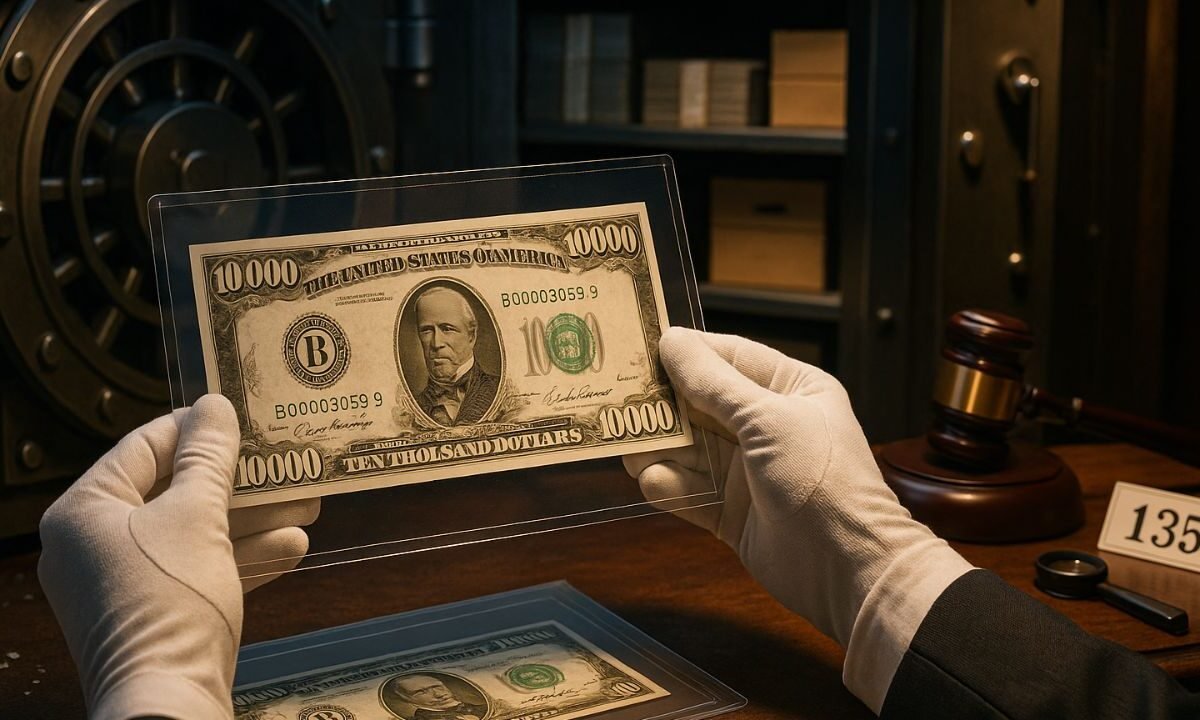For decades, the U.S. printed high-denomination notes—$500, $1,000, $5,000, and $10,000 bills—mainly for bank-to-bank settlements.
After electronic transfers took over, these notes were last printed in 1945 and formally discontinued in 1969.
Since then, the Federal Reserve has routinely pulled them from circulation and destroyed any that returned through banks.
That’s why survivors are rare and command strong prices at auction.
The Note You Can’t Own
The largest U.S. note ever made is the $100,000 Gold Certificate (Series 1934) featuring Woodrow Wilson.
It was never issued to the public—only used between Federal Reserve Banks—so private ownership is prohibited. Remaining specimens live in institutional collections and museum displays.
How Any Survived At All
Despite routine destruction, some notes escaped the shredder.
A few were set aside by collectors before 1969, others were held in bank archives, and many survived because museums and government institutions retained examples for history and education.
Importantly, the government still removes and destroys unfit currency every year, so the supply of high-denomination notes isn’t growing—it’s shrinking.
From Destruction To Record Prices
Because supply is thin and demand is strong, certified examples of $500, $1,000, $5,000, and $10,000 notes sell far above face value.
Pristine pieces from scarce districts or with exceptional eye appeal can bring five- to six-figure prices.
Earlier “trophy” notes—like ornate 19th-century Treasury Notes—have even set multi-million-dollar auction records, proving that survivors can travel a long road from vaults to auctions.
Famous U.S. Bills At A Glance
| Bill / Series | Last Public Use / Print | Why Most Were Destroyed | What Survived | Typical Market Reality* |
|---|---|---|---|---|
| $100,000 Gold Certificate (1934) | Inter-Fed use only | Not for public use; retired and retained | Institutional/museum specimens | Not legal for private ownership |
| $10,000 Federal Reserve Note (1934) | Discontinued 1969; pulled from banks | Obsolete for modern transfers | A small few hundred known to collectors | Six-figure results for certified notes |
| $5,000 Federal Reserve Note (1934) | Discontinued 1969; redemption programs | Same as above | Few hundred survivors | High five- to six-figure sales |
| $1,000 Federal Reserve Notes (1928/1934) | Discontinued 1969; heavy redemption | Banks withdrew and destroyed | Thousands remain | Four- to five-figure prices by grade |
| $500 Federal Reserve Notes (1928/1934) | Discontinued 1969; common redemptions | Most redeemed and shredded | Tens of thousands estimated | Lower entry point vs. $1,000+ notes |
| 19th-Century Rarities (e.g., “Watermelon” types) | Pre-Fed era | Small original issue; natural attrition | Handful of elite survivors | Record-setting multi-million sales |
*Ranges vary by district, series, condition, and certification.
What Drives Value Today
- Grade & Eye Appeal: Third-party-certified uncirculated notes with strong paper quality and bold inks earn premium multiples.
- Rarity By District: Some Federal Reserve districts printed fewer notes, making them harder to find.
- Pedigree & Story: Notes with museum provenance, old-time collections, or notable serial numbers attract aggressive bidding.
- Market Visibility: Feature lots at major auctions can spark competition and price spikes.
How Collectors Safely Participate
If you’re considering these notes, buy from reputable auctioneers or dealers and insist on recognized grading (to confirm authenticity and condition).
Store notes in archival sleeves, control humidity and light exposure, and keep documentation—certificates, invoices, and pedigrees—together for future resale value.
High-denomination notes were designed for a world that no longer exists. When the U.S. retired and destroyed them, only a thin trickle escaped into private hands.
That scarcity—combined with big-ticket history and undeniable visual appeal—explains how survivors moved from vaults to auctions, where they regularly achieve headline-making prices.
For collectors, each piece is more than money; it’s a rescued artifact of American finance.
FAQs
Are $500–$10,000 Bills Still Legal Tender?
Yes, $500, $1,000, $5,000, and $10,000 notes remain legal tender, but they’re worth far more as collectibles than their face value.
Can I Legally Own A $100,000 Gold Certificate?
No. The $100,000 Gold Certificate was for inter-bank transfers only and cannot be legally owned by private individuals.
How Much Do High-Denomination Bills Sell For?
It depends on series, district, and grade. $500 and $1,000 notes often realize four- to five-figure prices; $5,000 and $10,000 notes can reach the six-figure tier, with earlier rarities achieving record sums.

